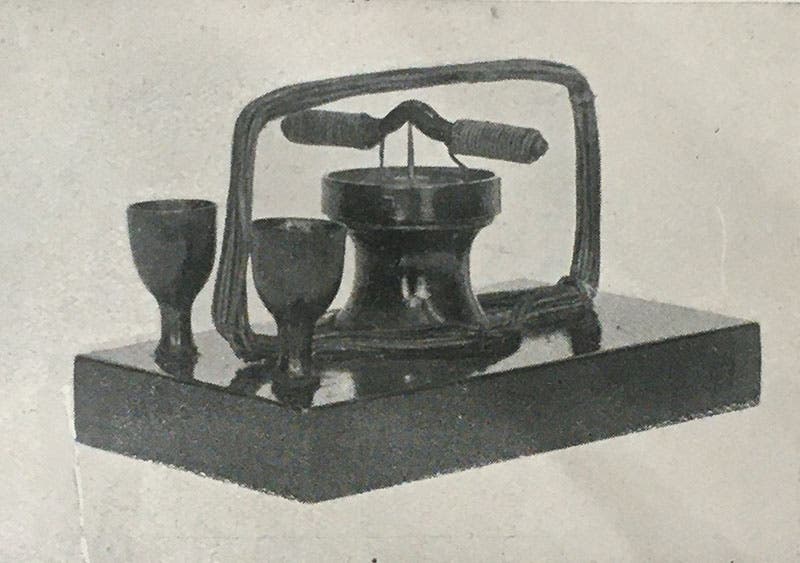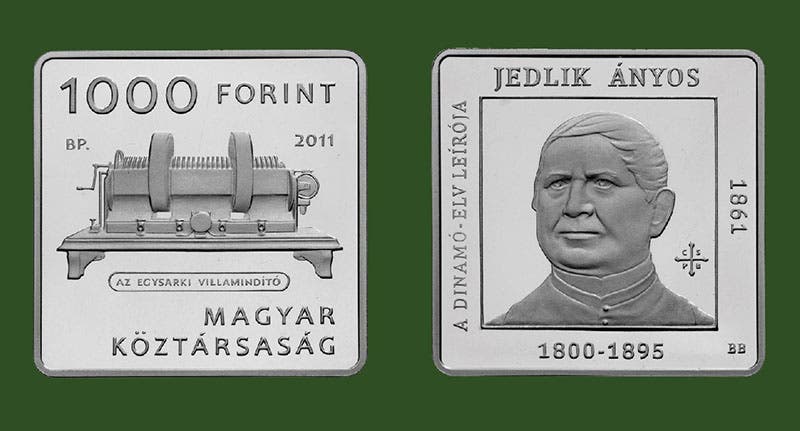Scientist of the Day - Ányos Jedlik
István Jedlik (first image), a physicist and electrical experimenter, was born on Jan. 11, 1800 in Szémo, a Hungarian village which has since become part of Slovakia. After attending secondary school, he entered the Benedictine order at the Pannonhalma Abbey, where he took the monastic name Anianus (or Ányos in Hungarian). He received his religious training in the abbey’s seminary, which also offered advanced classes in natural philosophy. By 1825, Jedlik had become a fully ordained priest and completed his doctorate. He decided to pursue a teaching career and joined the faculty at the University of Pest in 1840.
When he was not in the classroom, Jedlik devoted himself to the study of physics, which he viewed as a way to gain insights into both the natural world and its creator. He was particularly fascinated with the relationship between electricity and magnetism, which had received greater attention since Hans Christian Oersted’s 1820 article describing how a current passing through a wire deflected the needle of a nearby compass. In his efforts to tease out the relationship between these two forces, Jedlik designed several innovative pieces of experimental equipment that foreshadowed major developments in electrical engineering.
Jedlik’s first major invention expanded upon the work of Oersted, French physicist André-Marie Ampère, and British physical scientist Michael Faraday. Oersted had shown that an electric current generated a magnetic field, while Ampère confirmed that two wires carrying current exerted a force on each other. In 1821, Faraday combined these ideas to design the first electric motor, which demonstrated that electromagnetism could be converted into mechanical motion.
Jedlik started experimenting with electric motors in 1827. Unlike Faraday, whose motors required the use of permanent magnets, Jedlik’s machines relied solely on electromagnets, with one coil of wire (the rotor) spinning within a stationary electromagnetic frame (the stator). In addition, Jedlik introduced a special switch, now known as a commutator, that regularly reversed the direction of the electrical current in order to keep the rotor spinning continuously. Several of Jedlik’s prototypes have survived (second image), making them the earliest known devices to contain the three main components of a modern, direct-current motor (i.e. stator, rotator, and commutator).
Later on, Jedlik’s attention turned from motors to generators. Once again, he followed in the footsteps of Faraday. Having proved that electricity could be converted into mechanical motion, Faraday showed the reverse was also true: moving a conductor through a magnetic field induced an electric current. This discovery inspired the creation of machines that produced power by rotating coils of wire between the poles of an electromagnet. These early generators were relatively inefficient until the 1860s, when several engineers realized that they could divert a portion of the electricity that the generator produced back into the electromagnet, increasing both the field strength and the power output.
Werner Siemens and Charles Wheatstone published descriptions of this so-called “dynamo-electric principle” in 1867. At the time, they were unaware that Jedlik had built a small machine that operated along similar lines in 1861. This “unipolar inductor” could be seen as the first tentative step toward the production of affordable electrical power, which explains its appearance on a coin honoring Jedlik that was minted by the National Bank of Hungary in 2011 (third image).
It is important to emphasize that Jedlik chose not to publish articles about either his motors or his dynamo in any major scientific journals. The significance of his inventions was only recognized in hindsight, and neither had any direct influence on the subsequent development of those technologies. The same could not be said of his research into voltage multiplication.
Following the construction of his unipolar inductor, Jedlik began studying the Leyden jar, an early form of capacitor popular with electrical experimenters since the mid-18th century. In 1867, he created a new form of Leyden jar, which he referred to as a “tubular condenser.” He then proceeded to build an electrostatic generator, consisting of a “chain” of these condensers that were charged in parallel to one another. The condensers were then rotated so that their terminals touched, forming a series circuit and producing an electrical discharge whose voltage was several times larger than that used to charge the individual capacitors. Jedlik demonstrated his invention (fourth image) at the 1873 World’s Fair in Vienna and won over the crowd by creating sparks that were over 30 cm (12 inches) long. Jedlik won a medal for this apparatus and set the stage for further research into what came to be known as surge or impulse voltage generators.
Although reluctant to engage with his peers in other countries, Jedlik remained an active advocate for technical education in Hungary for over fifty years. In books, articles, and lectures, he emphasized the importance of science and engineering to that nation’s future and encouraged the standardization of Hungarian scientific vocabulary. He was elected to the Hungarian Academy of Sciences in 1858 and continued publishing articles in their journal after his retirement in 1879. Following his death in 1895, these efforts, as much as his inventions, ensured Jedlik’s reputation as one of Hungary’s leading electrical experimenters.
Benjamin Gross, Vice President for Research and Scholarship, Linda Hall Library. Comments or corrections are welcome; please direct to grossb@lindahall.org.









